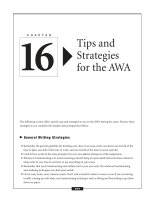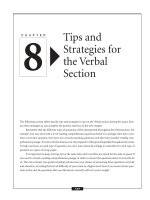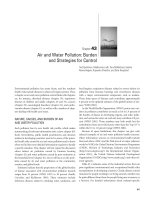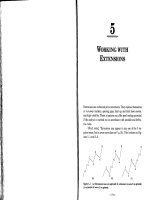Contemporary approaches and strategies for applied logistics
Bạn đang xem bản rút gọn của tài liệu. Xem và tải ngay bản đầy đủ của tài liệu tại đây (9.64 MB, 505 trang )
Contemporary
Approaches and
Strategies for Applied
Logistics
Lincoln C. Wood
University of Otago, New Zealand
A volume in the Advances in
Logistics, Operations, and
Management Science (ALOMS) Book
Series
Published in the United States of America by
IGI Global
Business Science Reference (an imprint of IGI Global)
701 E. Chocolate Avenue
Hershey PA, USA 17033
Tel: 717-533-8845
Fax: 717-533-8661
E-mail:
Web site:
Copyright © 2018 by IGI Global. All rights reserved. No part of this publication may be
reproduced, stored or distributed in any form or by any means, electronic or mechanical, including
photocopying, without written permission from the publisher.
Product or company names used in this set are for identification purposes only. Inclusion of the
names of the products or companies does not indicate a claim of ownership by IGI Global of the
trademark or registered trademark.
Library of Congress Cataloging-in-Publication Data
Names: Wood, Lincoln, 1981- editor.
Title: Contemporary approaches and strategies for applied logistics / Lincoln
C. Wood, editor.
Description: Hershey : Business Science Reference, [2018]
Identifiers: LCCN 2017038399| ISBN 9781522552734 (hardcover) | ISBN
9781522552741 (ebook)
Subjects: LCSH: Business logistics.
Classification: LCC HD38.5 .C653 2018 | DDC 658.7--dc23 LC record available at .
gov/2017038399
This book is published in the IGI Global book series Advances in Logistics, Operations, and
Management Science (ALOMS) (ISSN: 2327-350X; eISSN: 2327-3518)
British Cataloguing in Publication Data
A Cataloguing in Publication record for this book is available from the British Library.
All work contributed to this book is new, previously-unpublished material.
The views expressed in this book are those of the authors, but not necessarily of the publisher.
For electronic access to this publication, please contact:
Advances in Logistics,
Operations, and
Management Science
(ALOMS) Book Series
ISSN:2327-350X
EISSN:2327-3518
Editor-in-Chief: John Wang, Montclair State University, USA
Mission
Operations research and management science continue to influence business
processes, administration, and management information systems, particularly in
covering the application methods for decision-making processes. New case studies
and applications on management science, operations management, social sciences,
and other behavioral sciences have been incorporated into business and organizations
real-world objectives.
The Advances in Logistics, Operations, and Management Science
(ALOMS) Book Series provides a collection of reference publications on the
current trends, applications, theories, and practices in the management science field.
Providing relevant and current research, this series and its individual publications
would be useful for academics, researchers, scholars, and practitioners interested
in improving decision making models and business functions.
Coverage
• Decision analysis and decision support
• Risk Management
• Political science
• Organizational behavior
• Information management
• Marketing engineering
• Operations management
• Computing and information technologies
• Production management
• Networks
IGI Global is currently accepting
manuscripts for publication within this
series. To submit a proposal for a volume in
this series, please contact our Acquisition
Editors at or
visit: />
The Advances in Logistics, Operations, and Management Science (ALOMS) Book Series (ISSN 2327-350X) is
published by IGI Global, 701 E. Chocolate Avenue, Hershey, PA 17033-1240, USA, www.igi-global.com. This series
is composed of titles available for purchase individually; each title is edited to be contextually exclusive from any other
title within the series. For pricing and ordering information please visit Postmaster: Send all address changes to above address. ©© 2018 IGI
Global. All rights, including translation in other languages reserved by the publisher. No part of this series may be reproduced or used in any form or by any means – graphics, electronic, or mechanical, including photocopying, recording,
taping, or information and retrieval systems – without written permission from the publisher, except for non commercial,
educational use, including classroom teaching purposes. The views expressed in this series are those of the authors, but
not necessarily of IGI Global.
Titles in this Series
For a list of additional titles in this series, please visit:
/>
Motivationally Intelligent Leadership Emerging Research and Opportunities
Michael A. Brown Sr. (Florida International University, USA)
Business Science Reference • ©2018 • 139pp • H/C (ISBN: 9781522537465) • US $155.00
Novel Six Sigma Approaches to Risk Assessment and Management
Vojo Bubevski (Independent Researcher, UK)
Business Science Reference • ©2018 • 251pp • H/C (ISBN: 9781522527039) • US $200.00
Enterprise Resiliency in the Continuum of Change Emerging Research and Opportunities
Raj Kumar Bhattarai (Tribhuvan University, Nepal)
Business Science Reference • ©2018 • 186pp • H/C (ISBN: 9781522526278) • US $150.00
Examining Cultural Influences on Leadership Styles and Learning From Chinese...
Valerie Zhu (Xi’an University of Science and Technology, China)
Business Science Reference • ©2017 • 207pp • H/C (ISBN: 9781522522775) • US $125.00
Globalization and the Ethical Responsibilities of Multinational Corporations...
Tarnue Johnson (Argosy University - Chicago, USA)
Business Science Reference • ©2017 • 110pp • H/C (ISBN: 9781522525349) • US $125.00
Multi-Criteria Decision Making for the Management of Complex Systems
Albert Voronin (National Aviation University of Ukraine, Ukraine)
Business Science Reference • ©2017 • 201pp • H/C (ISBN: 9781522525097) • US $175.00
Handbook of Research on Manufacturing Process Modeling and Optimization Strategies
Raja Das (VIT University, India) and Mohan Pradhan (Maulana Azad National Institute of
Technology, Bhopal, India)
Business Science Reference • ©2017 • 530pp • H/C (ISBN: 9781522524403) • US $285.00
For an enitre list of titles in this series, please visit:
/>
701 East Chocolate Avenue, Hershey, PA 17033, USA
Tel: 717-533-8845 x100 • Fax: 717-533-8661
E-Mail: • www.igi-global.com
Table of Contents
Preface................................................................................................................. xvi
Section 1
Empirical and Inter-Firm Logistics and Supply Chain Issues
Chapter 1
Identifying the Key Success Factors in Strategic Alignment of Transport
Collaboration Using a Hybrid Delphi-AHP............................................................1
Yasanur Kayikci, Turkish-German University, Turkey
Michael R. Bartolacci, The Pennsylvania State University, USA
Larry J. LeBlanc, Vanderbilt University, USA
Chapter 2
The Evaluation of Environmental Capital Projects: The Way Forward................37
Frank Lefley, University of Hradec Kralove, Czech Republic
Joseph Sarkis, Worcester Polytechnic Institute, USA
Chapter 3
China’s Environmental Challenges: A Serious Risk Factor for Domestic
Development With Potential International Repercussions...................................58
Christian Ploberger, Independent Researcher, Austria
Chapter 4
The Effect of Supply Chain Sustainability Management in the Perspective of
Suppliers...............................................................................................................77
Jason X. Wang, University of Otago, New Zealand
Chapter 5
Modeling Enablers of Flexible Supply Networks Using Total Interpretive
Structural Modeling............................................................................................101
Surajit Bag, Tega Industries South Africa Pty Ltd, South Africa
Chapter 6
Eco-Labels and the Supply Chain: A Consumer-Oriented Perspective on
Supply Activities.................................................................................................130
Rikki Smith, University of Auckland, New Zealand
Lincoln C. Wood, University of Otago, New Zealand & Curtin
University, Australia
Chapter 7
Align Hospital Drug Delivery With Supply Chain Management: From
Process Analysis to Performance Measurement.................................................170
Alexis Nsamzinshuti, Université Libre de Bruxelles, Belgium
Alassane Ballé Ndiaye, Université Libre de Bruxelles, Belgium
Chapter 8
Identification of Contextual Relationship Among Collaboration, Cooperation,
Coordination, and Innovative Green Procurement Practices..............................201
Surajit Bag, Tega Industries South Africa Pty Ltd, South Africa
Chapter 9
Event Studies in Logistics Research: An Overview of the Method and
Application..........................................................................................................231
Lincoln C. Wood, University of Otago, New Zealand & Curtin
University, Australia
Section 2
Advances in Analytic Approaches
Chapter 10
The Agricultural Routing Planning in Field Logistics........................................261
Amalia Utamima, Curtin University, Australia
Torsten Reiners, Curtin University, Australia
Amir Ansaripoor, Curtin University, Australia
Hasan Seyyedhasani, University of Kentucky, USA
Chapter 11
The Value of Information Sharing: Impact of Inventory Policy, Pricing
Decision, and Product Substitution.....................................................................284
Linh N. K. Duong, Auckland University of Technology, New Zealand
Chapter 12
Forecasting Demand With Support Vector Regression Technique
Incorporating Feature Selection in the Presence of Calendar Effect..................302
Malek Sarhani, Mohammed V University, Morocco
Abdellatif El Afia, Mohammed V University, Morocco
Chapter 13
Innovative Port Logistics Through Coupled Optimization/Simulation
Approaches.........................................................................................................317
Mustapha Oudani, International University of Rabat, Morocco
Abderaouf Benghalia, University of Algiers I, Algeria
Jaouad Boukachour, University of Le Havre, France
Dalila Boudebous, University of Le Havre, France
Ahmed El Hilali Alaoui, Sidi Mohamed Ben Abdellah University,
Morocco
Chapter 14
A Contemporary Approach to Plan Independent Logistics Actors.....................337
Atour Taghipour, University of Le Havre, France
Chapter 15
Optimization of a Predictive Aircraft Maintenance Routing Model Using
Mutated Constrained Particle Swarm Optimization...........................................365
Abdellatif El Afia, Mohammed V University, Morocco
Malek Sarhani, Mohammed V University, Morocco
Chapter 16
Truck Driver Turnover: A Logistic Regression Approach.................................382
S. Scott Nadler, University of Central Arkansas, USA
John F. Kros, East Carolina University, USA
Compilation of References............................................................................... 405
About the Contributors.................................................................................... 468
Index................................................................................................................... 474
Detailed Table of Contents
Preface................................................................................................................. xvi
Section 1
Empirical and Inter-Firm Logistics and Supply Chain Issues
Chapter 1
Identifying the Key Success Factors in Strategic Alignment of Transport
Collaboration Using a Hybrid Delphi-AHP............................................................1
Yasanur Kayikci, Turkish-German University, Turkey
Michael R. Bartolacci, The Pennsylvania State University, USA
Larry J. LeBlanc, Vanderbilt University, USA
Transport collaboration has emerged as a growing trend that creates opportunities and
competitive advantages for supply chain partners by eliminating inefficiencies and
thus reducing costs. As a result, it allows the more efficient utilization of available
resources and mitigates greenhouse gas emissions. Ensuring a strategic alignment
among different partners is necessary to sustain a long-term collaboration with
respect to transport and logistics activities. This chapter studies strategic alignment
within the context of supply chain partners. The 37 key criteria from the technical,
risk, financial, organizational, and operational categories for the formation and
maintenance of a strategic alignment for collaboration are identified by utilizing a
hybrid Delphi-AHP. This methodology utilized the expertise of transport experts from
different countries. Establishing such collaborative initiatives from raw materials
procurement to finished products distribution throughout supply chain is important
for creating an efficient and environmentally/socially sustainable transport strategy.
Chapter 2
The Evaluation of Environmental Capital Projects: The Way Forward................37
Frank Lefley, University of Hradec Kralove, Czech Republic
Joseph Sarkis, Worcester Polytechnic Institute, USA
Traditional capital investment appraisal models are, in many cases, biased against
environmental projects. What is required is a multi-attribute approach that includes
an assessment of the environmental benefits. The financial appraisal profile (FAP)
model seeks to address this issue. By making the correct investment decision
in the first place and by involving senior managers in the appraisal process, the
organization is better placed to achieve project success. Adopting the FAP model
with the inclusion of an environmental assessment in the form the “environmental
score index” will help focus top management on an increasingly important corporate
strategy issue. An illustrative case study is used to outline the important aspects of
this new approach. The FAP approach, which is presented in this chapter, will help
to fill a gap in the environmental investment literature, where there is a paucity of
comprehensive, structured, and transparent methodologies that can prove acceptable
to management decision makers from a variety of functions and viewpoints.
Chapter 3
China’s Environmental Challenges: A Serious Risk Factor for Domestic
Development With Potential International Repercussions...................................58
Christian Ploberger, Independent Researcher, Austria
China’s environmental and climate-change-related risk provides serious challenges to
its development as they carry actual and potential social and economic implications
for the livelihood of its population. Among the various environmental risks China
faces, pollution in its various forms, drought and flooding, water scarcity, and sealevel rise are some of the more challenging ones. This variety of environmental issues
highlights the complexity of addressing and managing these challenges, not least
since China’s growth strategy has the potential to exacerbate the negative impact
on the environment, even when protecting the environment is a specific topic of the
13th Five Year Plan (2016-2020). China’s environmental and climate-change-related
challenge also carries regional and global implications by facilitating the global
climate change dynamic as well as increasing the negative impact on the regional
environment in northeast Asia. Even so, it would be misleading to identify China
as the major source of global climate change.
Chapter 4
The Effect of Supply Chain Sustainability Management in the Perspective of
Suppliers...............................................................................................................77
Jason X. Wang, University of Otago, New Zealand
This chapter investigates the suppliers’ economic performance when their buyers
force supply chain sustainability management (SCSM) on them. While generally a
negative impact is proposed, this chapter identifies mediating and moderating factors
fluctuating the negative performance. These factors are governance mechanisms,
SCSM dimensions, economic bond, and operational slack. According to the
findings, a conceptual framework is provided for supplier managers analyzing
SCSM-performance link and for affecting the decision making of buyer managers
and policy makers by accommodating suppliers perspectives.
Chapter 5
Modeling Enablers of Flexible Supply Networks Using Total Interpretive
Structural Modeling............................................................................................101
Surajit Bag, Tega Industries South Africa Pty Ltd, South Africa
The chapter aims to identify the contextual interrelationships among flexible
supply network enablers for achieving supply chain sustainability. The authors have
identified the enablers through a review of extant literature and further applied the
popular total interpretive structural modeling (TISM)-based methodology. TISM
is a well-articulated mental model interpreting both the nodes (indicating “what”)
and links (indicating “how” and “why”). The mental model of the group is not well
structured and is loosely defined, which serves as the basis for the theory building
process. The authors finally obtained a hierarchy of enablers and findings show that
innovation culture is the driving element in developing flexible systems in supplier
networks. Supply chain practitioners must focus on developing an innovation culture
within the boundaries of the organization and then integrate with specialist suppliers
to ultimately build additional capacity for managing the fluctuations in customer
demand and further manage supply risks. The chapter ends with conclusions drawn
from study and directions for future research studies.
Chapter 6
Eco-Labels and the Supply Chain: A Consumer-Oriented Perspective on
Supply Activities.................................................................................................130
Rikki Smith, University of Auckland, New Zealand
Lincoln C. Wood, University of Otago, New Zealand & Curtin
University, Australia
This chapter seeks to explore the concept of eco-labels as a method used by firms
to promote products with high levels of sustainability performance. The authors
examine what this means to the firms involved in terms of implementation and
impact on profit. However, they also examine what can happen when a firm fails
to live up to the required standards, whether these standards are above required
performance or even the minimum mandated performance. The authors use the case
of the automotive sector to demonstrate several categories of failure and provide a
concluding remark with several pathways forward for future research in this topic.
Chapter 7
Align Hospital Drug Delivery With Supply Chain Management: From
Process Analysis to Performance Measurement.................................................170
Alexis Nsamzinshuti, Université Libre de Bruxelles, Belgium
Alassane Ballé Ndiaye, Université Libre de Bruxelles, Belgium
In recent years, the European hospital sector has suffered the brunt of the economic
crisis. This sector is now faced with a paradox, which is to reduce costs, related to
the decline in government subsidies and an increase in the quality of care required
by the regulatory bodies, while maintaining the level of care. This paradox can be
resolved through the optimization of the hospital supply chain. Despite hospital
supply chains having a great impact on hospital budgets, many opportunities for
optimization exist to improve the healthcare quality. This chapter aims to analyze
the distribution of drugs within a hospital in the line of supply chain management.
The SCOR model was selected as the framework for this analysis. Then, potential
failures that can arise in logistics processes are identified. After reviewing the
literature regarding the hospital supply chain and the performance measurement,
a framework is proposed with key performance indicators that can be applied in
hospital supply chains to measure and monitor their performance.
Chapter 8
Identification of Contextual Relationship Among Collaboration, Cooperation,
Coordination, and Innovative Green Procurement Practices..............................201
Surajit Bag, Tega Industries South Africa Pty Ltd, South Africa
Globally, every organization is focusing on minimizing the usage of scarce resources
in production. The authors have used resource dependence theory (RDT) as the
theoretical lens to develop the foundation of the chapter. RDT suggests that firms
within the supply chain network should coordinate and collaborate to achieve superior
performance. Under RDT, the most important assumption is that firms cannot be
fully independent with regards to strategically critical resources for survival. The
purpose of this chapter is to explain the contextual relationships between collaboration,
coordination, cooperation, and innovative green procurement practices. Here,
interpretive structural modeling (ISM) technique has been used to develop the SSIM
matrix with the assistance from five experts based in the South African steel and
engineering sectors. The ISM model depicts the contextual interrelationships that
may help supply chain managers in quality decision making. The chapter concludes
with managerial implications and directions of future research.
Chapter 9
Event Studies in Logistics Research: An Overview of the Method and
Application..........................................................................................................231
Lincoln C. Wood, University of Otago, New Zealand & Curtin
University, Australia
The event study method allows researchers to examine the importance of an event to
firms based on the magnitude and direction of abnormal returns, and then use these
results in a cross-sectional regression to understand which managerial decisions may
affect these outcomes. While the method has been heavily used in some disciplines,
in-management research and logistics research, in particular, the method remains
little used and is often used with little thought to key assumptions and design
considerations. This chapter aims to provide an overview of the method for logistics
and supply chain researchers with a focus on developing the capability to design an
effective study and to evaluate research articles to determine possible weaknesses.
Section 2
Advances in Analytic Approaches
Chapter 10
The Agricultural Routing Planning in Field Logistics........................................261
Amalia Utamima, Curtin University, Australia
Torsten Reiners, Curtin University, Australia
Amir Ansaripoor, Curtin University, Australia
Hasan Seyyedhasani, University of Kentucky, USA
The agricultural sector is facing the need to gain a higher yield on their fields while
optimising their operations to stay competitive and satisfy the continuously increasing
demand for produce. Cost reductions can be achieved by increasing the effective
field size and reducing the operations without gain (e.g., driving longer distance to
harvest the field). The agricultural routing planning (ARP) problem represents a
specialisation of the travelling salesman problem (TSP) or vehicle routing problem
(VRP) with focus on the agricultural operations and considerations of the field
and vehicles configurations. In addition, various adaptations of the problem can be
found in the literature that define a new problem class with specialised optimisation
needs. This chapter introduces the ARP and reviews the past and current research
and developments.
Chapter 11
The Value of Information Sharing: Impact of Inventory Policy, Pricing
Decision, and Product Substitution.....................................................................284
Linh N. K. Duong, Auckland University of Technology, New Zealand
This chapter proposes a model to study the effects of inventory policy, pricing
decision, and product substitution on the value of information sharing. The value of
information sharing has been studied widely in the literature. To simplify models,
prior research usually studies a supply chain with one product. However, modern
supply chain models often produce and distribute ranges of products. Moreover,
manufacturers and retailers define prices for products based on demand forecast
and inventory levels or they even compete by using pricing decisions. Carefully
reading the extant literature, the authors found that no existing articles considers
the inter-relationship of inventory policy, pricing decision, and product substitution
when studying the value of information sharing. The proposed model in this chapter
will help to provide insights on the value of information sharing and fill the gap in
the literature.
Chapter 12
Forecasting Demand With Support Vector Regression Technique
Incorporating Feature Selection in the Presence of Calendar Effect..................302
Malek Sarhani, Mohammed V University, Morocco
Abdellatif El Afia, Mohammed V University, Morocco
Reliable prediction of future demand is needed to better manage and optimize
supply chains. However, a difficulty of forecasting demand arises due to the fact
that heterogeneous factors may affect it. Analyzing such data by using classical
time series forecasting methods will fail to capture such dependency of factors.
This chapter addresses these problems by examining the use of feature selection in
forecasting using support vector regression while eliminating the calendar effect using
X13-ARIMA-SEATS. The approach is investigated in three different case studies.
Chapter 13
Innovative Port Logistics Through Coupled Optimization/Simulation
Approaches.........................................................................................................317
Mustapha Oudani, International University of Rabat, Morocco
Abderaouf Benghalia, University of Algiers I, Algeria
Jaouad Boukachour, University of Le Havre, France
Dalila Boudebous, University of Le Havre, France
Ahmed El Hilali Alaoui, Sidi Mohamed Ben Abdellah University,
Morocco
This chapter addresses different optimization/simulation approaches for the innovative
logistics in Le Havre port in France. These approaches are applied to various
decisional problems raised in the maritime terminals (MT) and in the multimodal
terminal (MMT). The first problem concerns container transfer by rail between
the maritime terminals and the multimodal terminal. The second aims to optimize
trains/shuttles parking in the rail yard of the multimodal terminal. The third and
the fourth are about rail-rail transshipment of containers. The goal is to elaborate a
dashboard for decision makers to analyze and evaluate performance indicators of
port logistics chain (costs, resource occupancy rate, service rate) and to test several
management strategies.
Chapter 14
A Contemporary Approach to Plan Independent Logistics Actors.....................337
Atour Taghipour, University of Le Havre, France
Companies are dependent on the resources and information of other members of the
supply chains. To manage their resources, companies use coordination mechanisms.
Despite the inter-dependency between logistics actors, they are independent units
with conflicting objectives. These two characteristics can increase the complexity
of planning in logistics networks. According to the literature of supply chain
management, some mechanisms largely use the information shared by members
to achieve an optimal solution and some others are based on minimum level of
information sharing. This chapter addresses the coordination problem in a logistics
networks with more than two partners, while the information is in a private element
that is not exchanged with other partners.
Chapter 15
Optimization of a Predictive Aircraft Maintenance Routing Model Using
Mutated Constrained Particle Swarm Optimization...........................................365
Abdellatif El Afia, Mohammed V University, Morocco
Malek Sarhani, Mohammed V University, Morocco
Aircraft maintenance routing (AMR) is one of the most studied problems in the
airline industry and has gained much attention. The aim of this chapter is to solve
a mathematical formulation of the daily AMR problem, which aims to minimize
the routing cost while incorporating the risk of unscheduled maintenance. This
predictive model requires the optimization algorithm to both assure the feasibility
of the solution and to continuously track unscheduled maintenance events. To
address these issues, the authors propose a hybrid solution approach with two main
contributions: it examines the use of a binary version of particle swarm optimization
(PSO) adapted to this constrained optimization problem, and it consists of using an
adaptive mutation operator designed to deal with unscheduled maintenance.
Chapter 16
Truck Driver Turnover: A Logistic Regression Approach.................................382
S. Scott Nadler, University of Central Arkansas, USA
John F. Kros, East Carolina University, USA
The purpose of this chapter is to identify those constructs that lead to driver turnover
and to develop a logistic regression model to assist in predicting driver turnover.
Interviews with drivers were conducted with 154 drivers at large truck stops. The
theory of reasoned action (TRA), originating in the social psychology literature,
is the theoretical approach in this study. This chapter makes contributions in two
areas. From a managerial perspective, the study results indicate that companies can
use a technique such as logistic regression as part of their driver-retention efforts
in order to create competitive advantage by increasing efficiency and cutting costs.
The resulting logistic regression model provides a concrete tool for analyzing driver
turnover. Based on four factors, the model accounts for 84% of the variance and
accurately predicts which drivers or driver classes are most at risk of turning over.
Compilation of References............................................................................... 405
About the Contributors.................................................................................... 468
Index................................................................................................................... 474
xvi
Preface
Over several decades, many developments in global trade and geopolitics coupled
with societal progression over many parts of the world have combined to increase
the importance of logistics management. While in the past, many companies may
have been able to rely on outdated systems or methods managing their transportation
materials flow, in today’s society this part of the business has become increasingly
cutthroat and open to disruption from new technologies and innovative business
models. This book presents an overview of several important topics that will
help the reader come to grips with the fast-changing nature of the world and how
contemporary approaches can help logistics managers and analysts to succeed in
the face of rapid change. Also, there is a strong focus in these collected chapters on
the environmental and social sustainability of the business practices used.
The advent of containerisation played a large role in promoting greater global
trade and changing the face of many logistics systems at the national level. We have
seen a rapidly increasing trade, greater volumes, and greater value, as well as an
extensive use of a range of different transport modes depending on the requirements
of customers and product types. This increasing complexity is also lead to new
challenges for scholars and practitioners alike. In the current environment, it seems
as though globalisation and global trade is not something that we should take for
granted. Over 2016 and 2017, in both North America and across Europe, there have
been increasing political swings reflective of more protectionist concerns. There
remain significant strong agricultural lobby groups in many parts of the world.
Several national leaders have called for or threatened increasingly [protectionist
measures that might damage or reduce global trade volumes. Despite these recent
political changes, if logistics managers can continue to ensure the rapid, safe, and
environmentally effective flow of goods throughout the world and in a way that
benefits society broadly, many of the benefits of globalisation should continue to
be widely available despite the rising protectionist trend.
We have seen a significant change in how technology influences many elements
of logistics management. While this is not the primary focus of this volume, it is still
Preface
very much the cutting edge in the forefront of practice and research. The spreading
use of technology is now addressed by many firms over the globe and has a positive
impact even in emerging markets (Tatoglu et al., 2016) and will likely continue to
drive many improvements and changes to logistics practices and approaches in the
future.
Visibility has become increasingly important as many firms seek to understand
where specifically their assets are at any given time enabling them to track, monitor,
and reorganise assets in real time. Increased visibility can be useful in a range of
industries including distribution (Kärkkäinen, 2003) and agriculture, food, and
farming (Costa et al., 2013; Liu & Shao, 2012). Increased visibility can often lead
to significant improvements in the operational performance (Föhr, Karttunen,
Immonen, & Ranta, 2016). One of the big benefits of visibility is an increasingly
adaptive and flexible logistics application for many firms. Rather than relying on
optimised routes established once and then executed, firms may adapt and update
the routes for any given vehicle in real time, either within a facility such as with
forklifts (Poon et al., 2009) or outside facilities, such as managing freight transport
(Zacharewicz, Deschamps, & Francois, 2011). Visibility can also aid reverse logistics
processes (Lee & Chan, 2009). These benefits presuppose the ability to capture,
share, transmit, and analyse information with increasing speed.
Finally, the methods of the organisation have fundamentally changed. Whereas
once a strongly hierarchical model of management existed with the logistics manager
organizing or optimising fleets of delivery vehicles, we have increasingly seen in the
presence of disruptive technologies into the marketplace. The largest and perhaps
most prominent of these lends the company name to the description of this shift;
Uber, the transport on-demand ride sharing system, has been held up as a pinnacle
or a vanguard of this shift towards disruptive business models with the shift being
called Uberization. The peer-to-peer transactions in the Uberization model threaten
to cut out the middle man in many transactions and fundamentally re-organise how
firms manage their assets. The Uberization of logistics activities is still occurring
and represents an increasingly important topic for both business managers and
logistics researchers.
Some of the significant ways in which logistics approaches and applications
have changed include the use and management of Big Data, the focus on health
and safety in the workplace, and the increasing risk management and development
of consumer-focused outcomes.
•
Big Data: Previously, much of the forecasting and planning activities relied
on data collected by the firm or perhaps their major trading partners. In many
cases, data has been increasingly collected and used in real-time, providing
firms the opportunity to mine, analyse, and interrogate the data to improve
xvii
Preface
•
xviii
their decision-making in response to changes in the environment. Increasingly,
however, firms have gained the ability to draw on a much wider net and gain
data from a far more comprehensive set of sources enabling them more
perspective both on their immediate actions and also the other responses to
these actions (Hazen, Boone, Ezell, & Jones-Farmer, 2014). Weather data,
satellite images, and satellite-derived data, articles online, consumer reviews
of products, rainfall data, have all been brought together in different research
projects both commercially and academically to develop increasingly
sophisticated models. The scope and size of the data, the messiness of many
of the sources, the speed at which changes and is developed and transmitted,
as all lead to the development of the term big data (Waller & Fawcett, 2013).
The use of Big Data is increasingly of concern to many logistics managers. It
is also important to note, however, that the very presence of big data does not
lead automatically to changes. In many cases, there remain humans involved
in the process who have their own judgments and managerial perspectives
which alter and adjust how they use the data that they have (Wood, Reiners,
& Srivastava, 2017).
Health and Safety: Perhaps it is no surprise that given the size and mass of
much of the equipment used in the logistics industry the issue of health and
safety has also been an issue that many logistics managers about to address.
Across the world, many developed countries have been exerting greater
influence and control over the workplace to ensure the safety of workers. While
this might be broadly seen to increase push-up costs, the societal benefits of
safer working environments are almost indisputable and have led in some
instances to voluntary adoption of safety-focused improvements (Cantor
& Terle, 2010). Many of these changes have been forced on the industry
by changing regulation (Cantor, Macdonald, & Crum, 2011). However,
simultaneous technology changes are converging on many industries, leading
to many more managers looking for and examining ways to remove people
from the logistics process altogether. The focus on removing people has been
reflected in the rise of automated guided vehicles (AGV), the adoption of
robots, and driverless trucks. The changes in technology promise that these
vehicles should be more able to adapt much more quickly many cases than
a human could given changing environmental circumstances around them.
Use of technology in this way should reduce traffic incidents making the
roads safer for other vehicles and human passengers and those nearby. The
strong practical focus on health and safety that I have observed in working
environments over Australasia and in other parts of the world does not seem
to well-reflected in current research trends.
Preface
•
Risk Management and Consumer-Friendly Solutions: The increasing
globalisation of supply chains have seen many cases where there is increased
product mix and complexity in the logistics challenges associated with
moving products from manufacturers through to consumers. Throughout
this increasingly tangled web of activities and locations, there are increasing
opportunities for harm to occur both to people and to the natural environment.
Provision of information sharing technologies, such as radio frequency
identification (RFID) tags on products, can enable consumers to evaluate
products and interact with them in increasingly sophisticated ways (Kukard
& Wood, 2017).
The issue of consumer harm from products is an important one and while product
recalls are clearly connected to harm and damage, firms still face challenges dealing
with the recall process in cases of product failure (Wood, Wang, Olesen, & Reiners,
2017) and even the routine operations involved in product returns and reverse
logistics (Wu & Cheng, 2006). Product harm and reverse logistics are particularly
challenging in a world where there is an increasing amount of global trade between
borders supported by e-commerce (Giuffrida, Mangiaracina, Perego, & Tumino,
2017). While reverse logistics and closed-loop supply chains are seen as important,
many barriers are recognised in the implementation of reverse logistics (Chileshe,
Rameezdeen, Hosseini, & Lehmann, 2015). Increasingly, work is undertaken to
develop stronger reverse-logistics mechanisms and closed-loop supply chains
(Govindan, Soleimani, & Kannan, 2015).
•
Operations and Quality Management Perspectives to Improve
Outcomes: Firms increasingly focus on consumer-friendly solutions and
designs, often supported by operations and quality management principles in
non-traditional manufacturing fields. This can be seen with the adoption of
quality improvement approaches including consumer perspectives such as in
the refurbishment of housing (Juan, Perng, Castro-Lacouture, & Lu, 2009),
the design of hospitals (Wood, Wang, Abdul-Rahman, & Jamal Abdul-Nasir,
2016), and developing food products (Kuo, Yuo, & Lu, 2014).
The target audience for this book are business managers, logistics managers,
and analysts, research scholars, and advance postgraduate students – and each
group would use the volume in different ways. The volume tackles several pressing
practical issues both from a broad strategic and geopolitical perspective, such as the
perspective on Chinese business presented in Chapter 3, as well as getting down to
the nitty-gritty of different methods and their applications as presented in the second
section of the volume. The second section may be of interest to logistics research
xix
Preface
scholars and some technical analysts or technically minded logistics managers; it
provides greater insight into how to use different methods and their value. In this
way, the volume can serve as a useful supplement to a more management-oriented
postgraduate class (using the first section). More technically oriented undergraduate
or postgraduate classes would find value in the second section. As a stand-alone
volume, it will benefit business and practitioners as they seek to understand how to
apply new technologies and approaches or evaluate suggestions or business proposals
from within their own company. Instructors of undergraduate courses might find
some of the chapters to be relevant and a useful supplement to some of their teaching
where they can use a chapter as a solution to a particular problem or as a starting
point to lead the class in a discussion of a particular challenge.
In the first section of the volume, we focus on empirical and inter-firm logistics
and supply chain issues, often with a strong environmental and sustainability focus.
The many inefficiencies in transport and logistics could potentially be solved by
greater collaboration and Kayikci (Turkish-German University, Turkey), Bartolacci
(Pennsylvania State University, PA, USA), and LeBlanc (Vanderbilt University, TN,
USA) focus on heterarchical collaborative transport networks. If strategic alignment
between partners can be achieved, it should improve overall outcomes; this is
particularly crucial in heterarchical transport collaboration as leadership is shared
between users and providers of transport. Using a hybrid Delphi-AHP method, the
study used transport experts from different countries to understand the key criteria
for success in this type of collaborative network, using quantitative weightings
calculated using the AHP model.
Many capital investment appraisal models are focused on financial factors, and this
can create biases against environmentally beneficial projects with long-term horizons.
Lefley (University of Hradec Králové, Czech Republic) and Sarkis (Worcester
Polytechnic Institute, MA, USA) turn their attention to this and present the financial
Appraisal Profile (FAP) model, enabling users to develop an environmental score
index. The use of this normative tool can help focus managerial attention on this
increasingly important strategic issue and represents an effective support tool for
decision-makers to incorporate a pluralistic range of perspectives when evaluating
projects. Use of the tool should provide a more balanced perspective for investments
in a way that can enhance environmental sustainability.
The rise and opening of China’s economy have affected trade and international
relations worldwide, and Ploberger (independent researcher, UK, and Austria)
examines the environmental challenges that the country faces during this process.
The environmental and climate change risks pose a considerable challenge to Chinese
society and the Chinese economy. Examining the trends over time and some of the
underlying dynamics, the importance of energy demand are highlighted. The future
emissions are also highlighted as an area of challenge and concern. However, as
xx
Preface
with all governments, ensuring economic growth and prosperity is a fundamental
objective, and these environmental factors must be considered in the broader context
of these economic objectives.
Wang (University of Otago, New Zealand) examines how consumer-focused or
government-focused changes propagate upstream along the supply chain. The chapter
examines many of the important mechanisms for this enabling both scholars and
practitioners to understand and what circumstances sustainability initiatives may
have more or less impact on their suppliers. In an increasingly connected world,
when a firm decides to go green or increasingly become sustainable, they often have
a strong reliance on their trading and supply chain partners to make this happen.
Therefore, merely going green is not enough as the reliance on partners means that
some of the slack will be picked up by other trading firms. The impact on suppliers
is a key concern that Wang examines.
The increasingly global nature of supply chains and all of the interconnected
logistics activities has increasingly meant that firms have sought out how to develop
flexible supply networks editors of this topic that Bag (Tega Industries, South Africa)
focuses his attention. Through the total interpretive structural modelling approach
(TISM), the enablers of the flexible supply network that support supply chain
sustainability have been identified. This model demonstrates the importance of the
innovative culture and the need for firms to identify and develop deep relationships
with specialist suppliers to excel in the contemporary business environment. The
research underscores the importance of these strong dyadic linkages and how they
can be used to reduce uncertainty by managers.
Smith (University of Auckland, New Zealand) and Wood (University of Otago,
New Zealand) provide an overview of the increasingly important mechanism of
eco-labels to assure consumers of the credentials and providence of the products that
they are buying. They provide an overview of how this form of certification works in
principle – and also focus attention on what happens when firms fail to meet these
standards. Turning to the automotive sector to provide examples, they look at what
happens when some of the firms fail to meet government-mandated standards were
caught cheating (such as in the Volkswagen Dieselgate scandal). The style of failure
presents an important area for future research to both understand the consequences
of failure and also understand management mechanisms to prevent these outcomes.
In many regions of the world, there has been increasing focus on medical care and
efficiencies in the health sector. The healthcare sector is where Nsamzinshuti and
Ndiaye (Université Libre de Bruxelles, Belgium) turn their attention, by examining
how to increase the care provided while satisfying regulatory bodies and at the same
time, reducing or managing costs. Using the Supply Chain Operations Reference
(SCOR) model, the drug distribution and supply internally to the hospital is reviewed
with a framework provided to analyse failures and improve performance. Appropriate
xxi
Preface
performance indicators and methods to measure success are provided to enable
professionals to ensure the right drugs are available in the right place and time.
Going green and becoming sustainable often puts increasing pressure on
procurement teams to change their focus and it is this element of the supply chain
that Bag (Tega Industries, South Africa) turns his attention. Based on the resource
dependency theory, bag examines those key relationships with a strong focus
on collaboration, coordination, and cooperation between firms as they seek to
improve the sustainability and greenness of the supply chain procurement practices.
Interpretive structural modelling technique is being used with a specific focus on
stealing engineering sector. The chapter highlights the importance of coordination
and collaboration and the value from cross-functional teams coupled with regular
review exercises to ensure that both firms’ activities are sufficiently aligned.
Wood (University of Otago, New Zealand) presents an overview of an increasingly
important research method – the event study method. An overview specifically
addresses many of the researcher assumptions and methodological decisions that
must be made during the process. The chapter highlights many of the critical design
issues are important for the researchers using the method that also for the users of
the readers of the research to ensure that what they are reading is valid and useful.
A range of logistics related research articles are examined and the chapter concludes
with some areas of interest to both managers and researchers where the method can
still be used to shed light on existing problems.
Next, in the second section of the volume, we turn our attention to advances
in analytic approaches to help logistics and supply chain managers improve the
operational capabilities of their firms.
The agriculture sector constantly strives for improvements and one method to
achieve efficiency gains is through cost reductions by minimising the distance travelled
by vehicles. This is the focus of the chapter by Utamima, Reiners, Ansaripoor (Curtin
University, Western Australia) and Seyyedhasani (University of Kentucky, KY, USA),
as they examine the Agricultural Routing Planning (ARP) as a specialised form of
the Travelling Salesman Problem (TSP) or Vehicle Routing Problem (VRP). The
chapter provides an introduction to this problem, outlines key considerations, and
then presents a review of the state-of-the-art in the ARP.
The importance of information sharing and visibility over the supply chain
has been reflected in many models developed over the years, and it is in this area
that Duong (Auckland University of Technology, New Zealand) contributes. The
research proposes a model that examines product substitution and pricing decisions
in conjunction with inventory policy and a dyadic supply chain setting. This research
extends many models in a way that makes a more realistic and reflective actual
management practices with portfolios of products. Past research has shown that
xxii
Preface
inventory pricing and substitution are closely related and this chapter then highlights
the importance of information sharing within this context.
The reliable prediction of future demand for planning purposes in a supply
chain is made more difficult due to the many factors that may influence demand.
Sarhani and El Afia (Mohammed V University, Rabat, Morocco) investigate the
use of support vector regression approaches in conjunction with the use of the X13ARIMA-SEATS model to reduce the impact of calendar effect. Using three case
studies, they demonstrate the effectiveness of the approach.
With the rise of globalisation, trade and the movement of good has become
increasingly important and many countries have turned their focus to port
improvements. Oudani (International University of Rabat, Morocco) Abderaouf
(Algiers I University, Algeria), Boukachour (Normandy University, France),
Boudebous (Normandy University, France), El Hilali Alaoui (Sidi Mohamed Ben
Abdellah University, Fez, Morocco) focus their attention on innovative approaches
at Le Havre Port in France. They use optimization-simulation approaches to analyse
both the maritime terminals and the multimodal terminals to indicate how port
logistics chains can be improved over a rate of metrics (e.g., costs, utilization, and
service levels).
The effective management of resources even between two firms can be challenging,
and it is in this context that Taghipour (University of Le Havre, France) places his
attention. Examining the case of a to supply chain partners, a realistic scenario is
established by limited information focusing on order and supply proposals. The
coordination approaches proposed and used within the experimental framework of
the research use a minimal level of information sharing. Despite this, the coordination
mechanisms can be leveraged by the upstream supplier to improve their planning
processes. Negotiation between two firms in this way can have a significant influence
on their overall profitability and the supply chain effectiveness. The research shows
that the approach outlined holds benefits for upstream, supply-side, planning processes.
Maintenance scheduling is complicated due to the disruption caused by
unpredictable events requiring urgent maintenance. It is to this problem of Aircraft
Maintenance Routing (AMR) that Sarhani and El Afia (Mohammed V University,
Rabat, Morocco) turn their attention. Using a particle swarm optimization (PSO)
approach hybridized with an adaptive mutation operator, they demonstrate that they
can ensure the feasibility of solutions while managing the unscheduled maintenance
events. This is demonstrated to provide competitive results to simply using PSO.
The final chapter models truck driver turnover intentions. Nadler (University of
Central Arkansas, USA) and Kros (East Carolina University, USA) report on data
collected from 154 truck drivers at truck stops in North Carolina and Georgia. Based
on the Theory of Reasoned Action (TRA), the results indicate that from a practical
perspective, logistic regression can support accurate prediction of drivers or groups
xxiii
Preface
of drivers are most at risk of turning over. Using the model can enable a manager to
target and support truck drivers that are more likely to turnover. By targeted reduction
of turnover, a manager can help a firm to reduce costs and improve efficiency.
I hope that the readers of this volume find value in the collection of chapters and
can improve their management or research as a result.
Lincoln C. Wood
University of Otago, New Zealand & Curtin University, Australia
REFERENCES
Cantor, D. E., Macdonald, J. R., & Crum, M. R. (2011). The influence of workplace
justice perceptions on commercial driver turnover intentions. Journal of Business
Logistics, 32(3), 274–286. doi:10.1111/j.2158-1592.2011.01022.x
Cantor, D. E., & Terle, M. (2010). Applying a voluntary compliance model to a proposed
transportation safety regulation. International Journal of Physical Distribution &
Logistics Management, 40(10), 822–846. doi:10.1108/09600031011093223
Chileshe, N., Rameezdeen, R., Hosseini, M. R., & Lehmann, S. (2015). Barriers
to implementing reverse logistics in South Australian construction organisations.
Supply Chain Management, 20(2), 179–204. doi:10.1108/SCM-10-2014-0325
Costa, C., Antonucci, F., Pallottino, F., Aguzzi, J., Sarriá, D., & Menesatti, P. (2013).
A review on agri-food supply chain traceability by means of RFID technology.
Food and Bioprocess Technology, 6(2), 353–366. doi:10.1007/s11947-012-0958-7
Föhr, J., Karttunen, K., Immonen, M., & Ranta, T. (2016). Real-time monitoring system
for efficiency and cost analysis of forest energy biomass transportation. International
Journal of Applied Logistics, 6(1), 15–30. doi:10.4018/IJAL.2016010102
Giuffrida, M., Mangiaracina, R., Perego, A., & Tumino, A. (2017). Cross-border
B2C e-commerce to Greater China and the role of logistics: A literature review.
International Journal of Physical Distribution & Logistics Management, 47(9),
772–795. doi:10.1108/IJPDLM-08-2016-0241
Govindan, K., Soleimani, H., & Kannan, D. (2015). Reverse logistics and closed-loop
supply chain: A comprehensive review to explore the future. European Journal of
Operational Research, 240(3), 603–626. doi:10.1016/j.ejor.2014.07.012
xxiv









